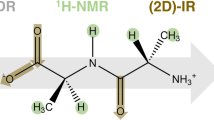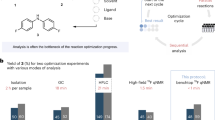Abstract
WE report here the development of a rapid new method for the analysis of mixtures of peptides and amino-acids. This technique is based on the measurement of the 19F nuclear magnetic resonance spectra of trifluoroacetyl or other fluorine containing derivatives of peptides and amino-acids. Earlier we reported that fluorine magnetic resonance can be used for the quantitative analysis of mixtures of metals as chelate derivatives of trifluoracetylacetone (unpublished results of R. E. S.). Although the proton resonance spectra of Zr(IV) trifluoracetylacetonate and Hf(IV) trifluoracetylacetonate in chloroform are essentially the same, the fluorine resonance peaks are well separated (0.23 p.p.m.) and easily integrated to provide quantitative analysis of Zr and Hf. It is well known that the fluorine chemical shift is much more sensitive (between one and two orders of magnitude) to small differences in shielding than the proton resonance. Experience with the fluorine magnetic resonance of extremely similar metal chelates1 led us to conclude that the same advantage could be realized in detecting small differences in chemically and structurally similar peptides and amino-acids. Accordingly, the N-trifluoracetyl derivatives of the amino-acids and peptides shown in Table 1 were prepared and the fluorine NMR spectra measured. It is readily seen in Table 2 and Figs. 1 and 2 that the fluorine nuclei reflect small differences in structure, acting as what might be termed sensors, with the resonance peak for each trifluoracetyl group appearing at a characteristic field position.
This is a preview of subscription content, access via your institution
Access options
Subscribe to this journal
Receive 51 print issues and online access
$199.00 per year
only $3.90 per issue
Buy this article
- Purchase on Springer Link
- Instant access to full article PDF
Prices may be subject to local taxes which are calculated during checkout
Similar content being viewed by others
References
Fortman, J. J., and Sievers, R. E., Inorg. Chem., 6, 2022 (1967).
Weygand, F., and Geiger, R., Chem. Ber., 89, 1543 (1956).
Bayer, E., Gas Chromatography (edit. by Desty, D. H.), 333 (Butterworth, London, 1958).
Bayer, E., and König, W. A., Advances in Gas Chromatography (edit. by Zlatkis, A., and Ettre, L.), 187 (Preston Publishing Co., Evanston, 1969).
Gehrke, C. W., and Stalling, D. L., Separation Science, 2, 101 (1967).
Weygand, F., Prox, A., Schmidhammer, L., and König, W., Angewandte Chemie, Int. Ed., 2, 183 (1963).
Author information
Authors and Affiliations
Rights and permissions
About this article
Cite this article
SIEVERS, R., BAYER, E. & HUNZIKER, P. Fluorine Nuclear Magnetic Resonance of Peptides and Amino-acids. Nature 223, 179–181 (1969). https://doi.org/10.1038/223179a0
Received:
Revised:
Issue Date:
DOI: https://doi.org/10.1038/223179a0
This article is cited by
-
Liquid Phase Synthesis of Peptides
Nature (1972)
-
Analyse von Hydroxysteroiden mit Hilfe der19F-NMR-Spektroskopie
Fresenius' Zeitschrift für analytische Chemie (1970)
Comments
By submitting a comment you agree to abide by our Terms and Community Guidelines. If you find something abusive or that does not comply with our terms or guidelines please flag it as inappropriate.



